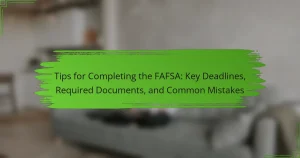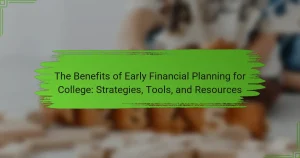
What are Work-Study Programs?
Work-study programs are federally funded initiatives that provide part-time jobs for students. These jobs help students earn money to pay for their education expenses. Work-study is typically offered through financial aid packages. Students must demonstrate financial need to qualify. Positions can be on-campus or off-campus. Employers include schools, nonprofit organizations, and government agencies. The program encourages community service and work experience. According to the National Center for Education Statistics, over 700,000 students participate in work-study each year.
How do Work-Study Programs function?
Work-study programs function by providing students with part-time employment opportunities to help finance their education. These programs are typically funded by the federal government or educational institutions. Students must demonstrate financial need to qualify for work-study positions. Participants work in various roles on campus or with approved off-campus employers. The earnings from these jobs help cover tuition and other educational expenses. Work-study positions often offer flexible hours to accommodate students’ class schedules. According to the U.S. Department of Education, students can earn a maximum amount based on their financial need and the availability of funds. This structure supports both educational goals and practical work experience.
What are the eligibility requirements for Work-Study Programs?
To be eligible for Work-Study Programs, students must demonstrate financial need. This need is typically assessed through the Free Application for Federal Student Aid (FAFSA). Students must also be enrolled in an eligible degree or certificate program. Additionally, they must maintain satisfactory academic progress as defined by their institution. Eligibility may vary based on the institution’s specific criteria and available funding. Federal Work-Study is available to undergraduate and graduate students. Some states and schools also offer their own work-study programs with different requirements.
What types of institutions offer Work-Study Programs?
Colleges and universities typically offer Work-Study Programs. These programs are designed to help students earn money while attending school. Many institutions participate in federal work-study programs, which provide funding through the U.S. Department of Education. Community colleges also frequently offer work-study opportunities to assist students with financial needs. Some private institutions have their own work-study programs funded by the school. Non-profit organizations may partner with educational institutions to provide work-study positions. Overall, a variety of educational settings provide work-study options to support students financially.
What are the core benefits of participating in Work-Study Programs?
Participating in Work-Study Programs provides financial assistance, practical work experience, and skill development. Students can earn money to help pay for education expenses. These programs offer hands-on experience in a professional setting. This experience enhances resumes and improves employability after graduation. Additionally, work-study positions often relate to students’ fields of study. This alignment helps in building relevant skills and networking opportunities. According to the National Center for Education Statistics, about 70% of students in work-study programs report satisfaction with their job relevance. This satisfaction contributes to a more engaged and informed student body.
How do Work-Study Programs enhance academic performance?
Work-study programs enhance academic performance by providing students with practical work experience alongside their studies. This dual engagement helps students develop time management skills. Balancing work and academics fosters discipline and responsibility. Additionally, students gain financial support, reducing stress related to tuition costs. Research indicates that students in work-study programs often achieve higher GPAs. A study by the National Center for Education Statistics found that these students are more likely to persist in their studies. The hands-on experience also reinforces classroom learning, making academic concepts more relatable. Overall, work-study programs create a supportive environment that positively impacts academic outcomes.
What financial advantages do Work-Study Programs provide?
Work-Study Programs provide financial advantages by offering students part-time employment opportunities that help offset educational costs. These programs allow students to earn money while attending school, reducing the need for student loans. Work-study earnings can be used for tuition, books, and living expenses. According to the National Center for Education Statistics, students participating in work-study programs can earn an average of $2,000 to $3,000 per academic year. Additionally, these positions often accommodate class schedules, enabling students to balance work and study effectively. This flexibility can lead to better academic performance, ultimately enhancing the value of the financial support received.
What job opportunities are available through Work-Study Programs?
Work-study programs provide various job opportunities for students. These positions often include roles in administrative support, research assistance, and tutoring. Many students may work in libraries, laboratories, or campus offices. Some opportunities may also be available in community service or nonprofit organizations. Work-study jobs are designed to accommodate students’ schedules. They typically offer flexible hours that align with class times. According to the National Center for Education Statistics, over 700,000 students participated in work-study programs in the 2019-2020 academic year. This indicates a strong demand for such job opportunities among students.
What types of jobs can students expect in Work-Study Programs?
Students can expect a variety of jobs in Work-Study Programs. Common positions include administrative roles, research assistantships, and tutoring jobs. Many students work in libraries or campus facilities. Some also find jobs in community service or nonprofit organizations. These positions often align with students’ academic interests. Work-study jobs typically offer flexible hours to accommodate class schedules. According to the Federal Work-Study program, these jobs help students earn money while gaining experience. This combination of work and study supports both financial needs and professional development.
How do Work-Study jobs relate to students’ fields of study?
Work-study jobs often align with students’ fields of study to provide relevant experience. These positions can enhance practical skills related to academic coursework. For instance, a student majoring in education may work in a tutoring center. This role directly relates to their future career as a teacher. Similarly, a student studying business might work in a marketing department. This experience can improve their understanding of real-world business operations. Research shows that 70% of students find work-study jobs beneficial for career preparation. These jobs bridge the gap between theory and practice, making education more applicable.
What are the hour limitations in Work-Study Programs?
Work-study programs typically limit student work hours to 20 hours per week during the academic year. This limitation ensures that students can balance their academic responsibilities with work commitments. During school breaks, students may work up to 40 hours per week. The specific hour limitations can vary by institution and program. Federal guidelines also govern these limits to promote student success. Compliance with these hour restrictions is essential for maintaining eligibility in work-study programs.
How are work hours determined for Work-Study participants?
Work hours for Work-Study participants are determined by the financial aid office and the student’s enrollment status. The financial aid office assesses the student’s financial need and allocates a specific work-study award amount. This award typically dictates the maximum number of hours a student can work. Students are generally limited to a maximum of 20 hours per week during the academic year. However, this limit may vary based on the institution’s policies and the student’s academic schedule. Work hours may also increase during breaks when students can work full-time. Institutions often consider the student’s class schedule to avoid conflicts.
What are the consequences of exceeding hour limitations?
Exceeding hour limitations can lead to penalties for both employees and employers. Employees may face loss of eligibility for financial aid or work-study programs. Employers can incur fines or legal action for violating labor laws. Additionally, excessive work hours can lead to burnout and decreased productivity. Studies show that overworking can negatively impact mental health. For instance, the American Psychological Association notes increased stress levels among overworked individuals. This stress can result in absenteeism and reduced job performance. Therefore, adhering to hour limitations is crucial for maintaining compliance and well-being.
How can students maximize their experience in Work-Study Programs?
Students can maximize their experience in Work-Study Programs by actively engaging in their roles and seeking learning opportunities. They should communicate regularly with supervisors to understand expectations and receive feedback. Networking with colleagues can provide insights and enhance job performance. Setting clear goals for both work and academic achievements is crucial. Time management skills are essential to balance work hours and study commitments effectively. Participating in training sessions can improve skills relevant to their job roles. Reflecting on experiences can help identify areas for personal and professional growth. Research indicates that students who take an active role in their work-study positions report higher satisfaction and skill development.
What strategies can help students balance work and study effectively?
Students can balance work and study effectively by implementing time management techniques. Prioritizing tasks helps students focus on what is essential. Creating a schedule allows students to allocate specific time blocks for work and study. Utilizing tools like planners or digital apps can enhance organization. Setting realistic goals ensures that students do not overwhelm themselves. Taking regular breaks improves concentration and reduces burnout. Communicating with employers about academic commitments can lead to flexible work arrangements. Studies show that students who manage their time well achieve better academic performance.
What resources are available to support Work-Study participants?
Work-Study participants have access to various resources for support. These include financial aid offices that provide guidance on eligibility and application processes. Career services offer job placement assistance and resume workshops. Academic advisors help students balance work and study commitments. Additionally, counseling services are available for personal and academic challenges. Many institutions also provide online resources, including webinars and informational guides. These resources aim to enhance the Work-Study experience and ensure participants succeed academically and professionally.
Work-study programs are federally funded initiatives that provide part-time job opportunities for students to help finance their education expenses. This article outlines the eligibility requirements, types of institutions offering these programs, and the core benefits of participation, such as financial assistance and practical work experience. It also explores the various job opportunities available, hour limitations, and strategies for maximizing the work-study experience. Additionally, resources to support students in balancing work and academic commitments are highlighted, ensuring a comprehensive understanding of work-study programs.




